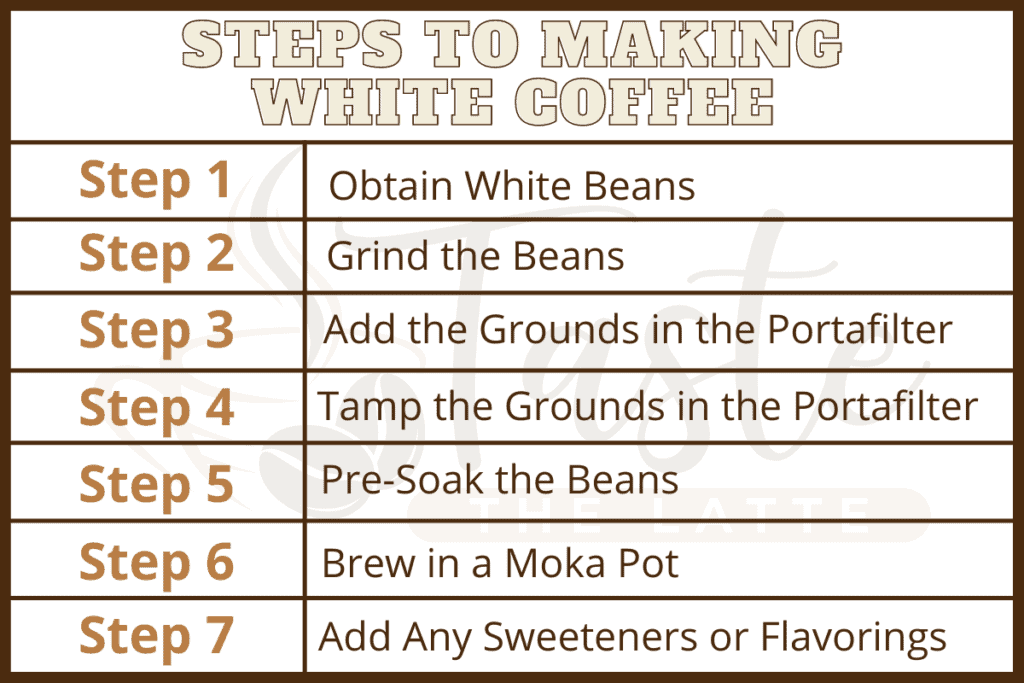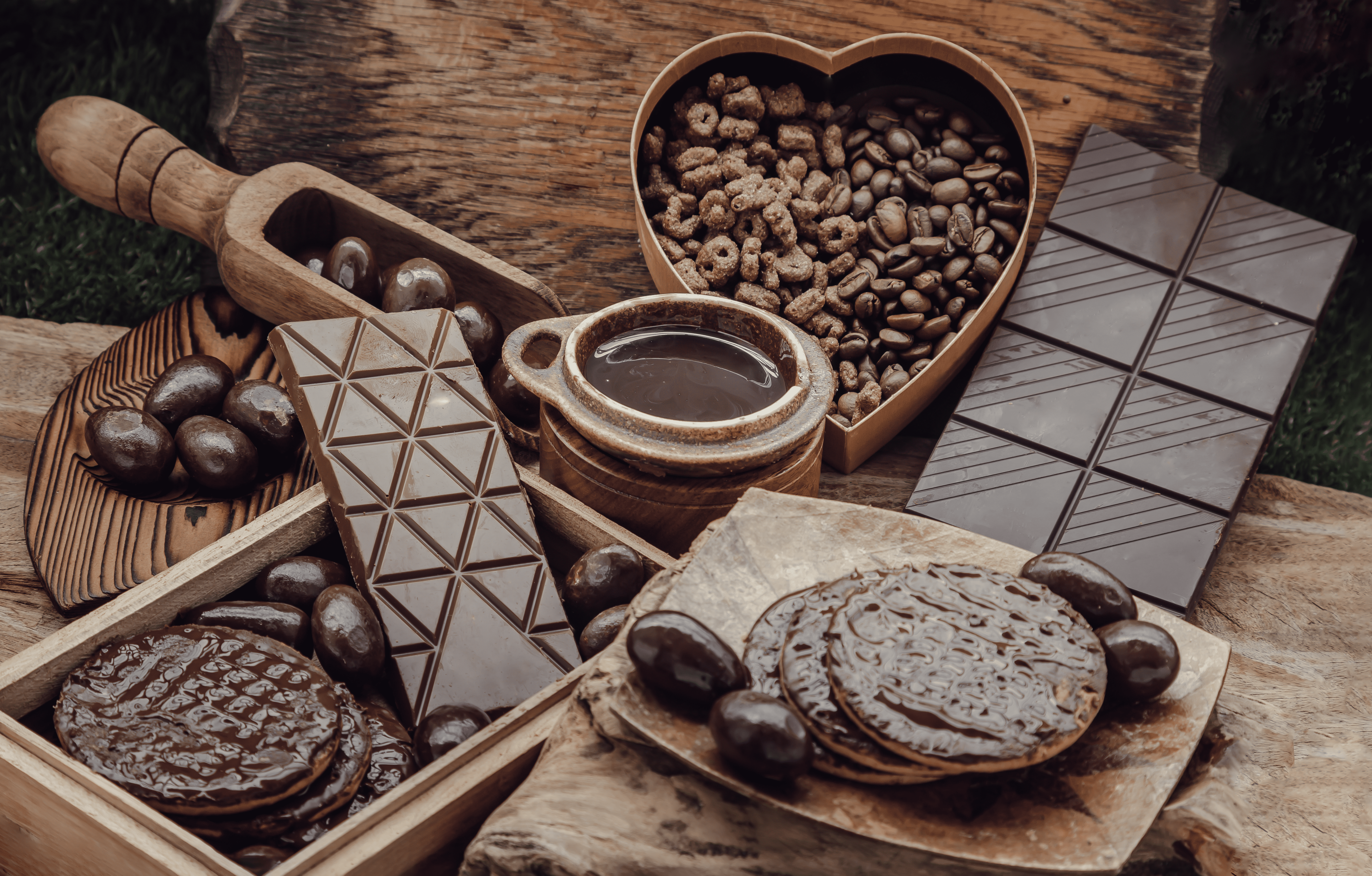You’ve heard of people taking their coffee black but never white. You’re very intrigued and would love to try making white coffee at home. How do you do it?
Here’s how to make white coffee at home:
- Grind white coffee beans (or buy pre-ground beans)
- Tamp the grounds in the portafilter
- Pre-soak the beans
- Brew in a Moka pot
- Add any sweeteners and flavorings
If you want to learn all about the magic that is white coffee, you’ve come to the right place. This guide will explain what white coffee is, how to brew it, how to drink it, what it should taste like, and whether it’s healthy. You won’t want to miss it!
What Is White Coffee?
As we mentioned in the intro, most coffee drinkers are very familiar with black coffee but likely not as well-versed with white coffee. We’re here to change that.
White coffee is not a cup of black coffee that you dump so much milk into that it becomes lighter. Rather, it’s coffee made with white coffee beans.
Yemen is the home of white coffee, which is not some new, hip trend but has actually been around for more than 100 years.
Admittedly, white coffee beans are not as high in quality as darker beans, which is why they require only a partial roasting rather than a full roasting. The green coffee beans are roasted at a lower than normal temperature and are done before the first crack. White coffee can be made from Robusta or Arabica beans.
This is the trickiest part of making white coffee but is critical in getting a nutty and not bitter flavor.
How Is It Different Than Flat White?
To the initiated, white coffee can easily be confused with a flat white, at least by looks alone, but these two caffeinated beverages couldn’t be any more different.
A flat white is a type of espresso made with steamed milk. Unlike white coffee, which gets its color from its beans, a flat white is tinted that pale hue because of the inclusion of milk.
You’ll recall that white coffee is not espresso. It’s coffee. It also doesn’t need milk. You can always add some milk to your white coffee if you’re interested, but it’s not a required ingredient as it is with a flat white.
How to Make White Coffee at Home
You popped into a few local cafés, but none serve white coffee. You really want to try the stuff yourself, so you figured you’d make it a home.
What a great choice! You’ll enjoy fresh, rich-tasting coffee…once you nail down the proper brew settings for white coffee.
Before you start, you’ll need white coffee beans, a portafilter, and a Moka pot for the most authentic white coffee.
Now you’re ready to get brewing!

Let’s dig a little deeper into each one of the steps listed above.
Step 1 – Obtain White Beans
You can’t use just any coffee beans to make white coffee, as we hope we’ve clarified. You need white roast beans.
Just where in the world are you going to procure the right beans for the job? You can check the grocery stores in your neighborhood or maybe some cafés.
If that doesn’t work, then you can always shop online. White coffee beans are abundant there.
We quite like Poverty Bay Coffee Co.’s White Tornado white roast coffee beans, which you can buy in one-pound or two-pound bags.
Abbey Roast’s 12-ounce white coffee bags are another good option if you want white beans in a smaller quantity. The whole beans are high-quality Arabica beans that are sure to have an incredible depth of flavor.
Step 2 – Grind the Beans
You’ll have to grind them if you’re buying whole white beans like those from Abbey Roast. This does add an extra step, so we don’t recommend it if you’re trying to brew coffee in a jiffy before work.
You might not mind grinding your own beans on the weekends or the mornings when you have more time.
You don’t have to grind white coffee beans any special way, so use the same grinder you always do when making coffee at home. Just make sure it’s clean, so you don’t get any dark bean residue in your white coffee.
We use and love our Baratza Encore Conical Burr Coffee Grinder in my house.
Step 3 – Add the Grounds in the Portafilter
Next, you will need a portafilter, also known as the group handle.
The portafilter is a device commonly seen in espresso machines. It will include a basket for keeping the ground coffee.
The grounds stay in the basket when you extract or pull an espresso shot.
You only need seven grams of ground beans if you want to make a single shot of white coffee. For a double shot, add 15 grams of grounds to the portafilter.
You should use a coffee measurer to determine the precise amount of grounds to use.
However, if you’re short on time, you should be able to get away with eyeballing it well enough, especially if you brew coffee at home all the time.
This tip will help. You should add enough white coffee grounds to the portafilter that the filter is full and rounded at the top.
Step 4 – Tamp the Grounds in the Portafilter
You might have seen baristas tamp your coffee when making it at your favorite café, but you’re not sure why they did it.
Tamping takes the loosened ground coffee beans and compresses them into the portafilter.
There’s an ongoing argument among coffee aficionados about whether you should tamp coffee grounds when making white coffee.
We’d say it’s worth doing. White coffee beans have different characteristics than the darker beans you’re used to working with.
They don’t absorb water as readily, for one. The texture of the beans is also harder and grittier. Tamping does help, so don’t skip it if you want a high-quality cup.
Step 5 – Pre-Soak the Beans
Pre-soaking the white coffee beans is also highly recommended if you want more flavor out of your white coffee.
The protocol for pre-soaking is starting a shot, counting to four, and then stopping the shot. After 20 seconds, you could then brew your shot.
Step 6 – Brew in a Moka Pot
Although you have other options, such as the AeroPress, the Moka pot remains a popular pick for making white coffee.
Did you know that the Moka pot is named after Mocha, a city in Yemen? That’s right, the same Yemen where white coffee originated. That’s why white coffee and the Moka pot are a match made in heaven!
Boil four ounces of filtered water on the stove for the Moka pot. As the water boils, take it off the stove and pour all four ounces into the Moka pot’s bottom chamber. The chamber will be 1/4th full.
Fill the filter basket with up to 15 grams of ground white coffee beans and shake the basket until the beans are level. Put on the top chamber and transfer the Moka pot to the stovetop.
Set the stove heat to medium and allow the water in the bottom chamber to boil. This should only take a couple of minutes. When the Moka pit hisses, you’re finished.
Step 7 – Add Any Sweeteners or Flavorings
Congratulations, you’ve made white coffee! All there is to do now is add any flavorings or sweeteners you want, such as cream, milk, or sugar.
If you want to drink white coffee the way it’s traditionally consumed in Yemen, then be sure to add hawaij, a ground spice that includes flavor notes of cardamom, turmeric, black pepper, and cumin.
What Does White Coffee Taste Like?
You’ve let it cool just a bit, and you’re ready to take your first sip of white coffee. What exactly is it going to taste like?
Well, if you brewed it properly, then white coffee shouldn’t taste very bitter since it doesn’t roast long. It’s much like light roasts with it’s acidity and strong nutty flavor.
The strength and boldness of white coffee might be more than you would have expected, which can leave you feeling blown away!
How Should You Drink White Coffee?
When we talked about how to make white coffee, we mentioned how you could add sweeteners and flavors, including hawaij, a special Yemen seasoning that really adds a whole new dimension to white coffee.
Is that how you’re supposed to drink this light beverage?
Actually, the ideal way to drink white coffee is black, i.e., with nothing other than the coffee, including the omission of cream, sugar, and milk.
This allows you to take in the full nutty depth of white coffee’s flavor, which will really dazzle you.
If you must add a splash of sweetness, almond milk complements white coffee the best since it brings out the nutty flavor of the caffeinated beverage quite well.
Other common added spices include nutmeg, ginger, and cinnamon. Click the link to learn how to infuse coffee with cinnamon.
We should note that those with acid reflux disease and/or heartburn might not want to drink white coffee black. You’ll recall how it’s quite acidic, and the high levels of acidity will surely aggravate your condition(s).
You’re best off adding milk or creamer to neutralize the acidity.
Does White Coffee Contain More Caffeine Than Other Types of Coffee?
Some people prefer slowly sipping on coffee throughout the whole morning to get their daily dose of caffeine. Others prefer drinking one or two supercharged cups of coffee and then being on their way.
You’ll love white coffee if you’re in the latter camp.
Since it’s roasted to only 325 degrees Fahrenheit versus the 450 to 480 degrees that other types of coffee are roasted to, white coffee has at least 50 percent more caffeine.
That’s quite a jump in caffeine from the coffee you’re used to consuming! You’ll want to tread carefully and start with only one cup of white coffee and then see how you feel before you gulp down another.
After all, while caffeine gives you the energy you need to get through your day, being overcaffeinated is not great for your health or concentration. You’ll feel jittery, anxious, and unable to stay in one spot for long.
Keep in mind that the more caffeinated your coffee, the harder the crash will be later. That’s another reason to carefully monitor your caffeine intake the first few times you drink white coffee.
Is White Coffee Healthy?
When drunk in moderation, coffee is considered quite good for your health. The caffeinated beverage might reduce your type 2 diabetes risk, keep your heart and brain healthy, safeguard your liver, and maintain a healthier weight.
When you roast coffee beans too much, you can eliminate much of the healthy properties of the coffee. This is sort of like how when you remove the peels of an apple or potato, you’re reducing the health benefits of the produce.
The roasting process is much shorter for white coffee beans, so more of those healthy properties of the coffee are packed into each cup. White coffee beans contain more chlorogenic acid which increases the antioxidant properties.
That said, we must remind you that the caffeine content of white coffee is moire than your average cup of dark roast coffee.
You’re only supposed to consume 400 milligrams of caffeine per day (unless you’re pregnant, then it’s less still) per recommendations from the U.S. Food and Drug Administration. Be careful not to overdo it on the caffeine!
What is a Flat White Then?
A Flat White is a smaller, stronger latte usually served in a 6oz cup. It is typically made with a double shot of espresso, steamed milk and a thin layer of microfoam on the top, often with latte art in it.
This layer of foam is the highest quality of frothed milk due to the size of the bubbles. They are so small and abundant that it gives the drink a velvety texture.
Nearly any type of milk can be used in making froth with a handheld milk frother or steam wand, but baristas typically use whole milk to create those tiny air bubbles.
To read more about flat whites, click the link.
Final Thoughts
White coffee is a delicious take on coffee that’s made by lightly roasting white beans. The result is a nutty, acidic coffee that tastes great on its own or with some sugar, milk, or even a Yemen spice blend known as hawaij.
Do keep in mind that white coffee is at least 50 percent more caffeinated than regular coffee, so a little goes a long way towards putting a pep in your step!
Can You Brew Coffee Using Chocolate-Covered Coffee Beans?
You recently received a thoughtful treat from a friend of yours: chocolate-covered coffee beans. You could eat them straight out of the box, but then you have another thought. Since…
How Much Coffee Can You Take on a Plane?
You want to take your favorite coffee with you on a trip or bring some home on vacation. To do so, you must pack it carefully and likely bring it…


